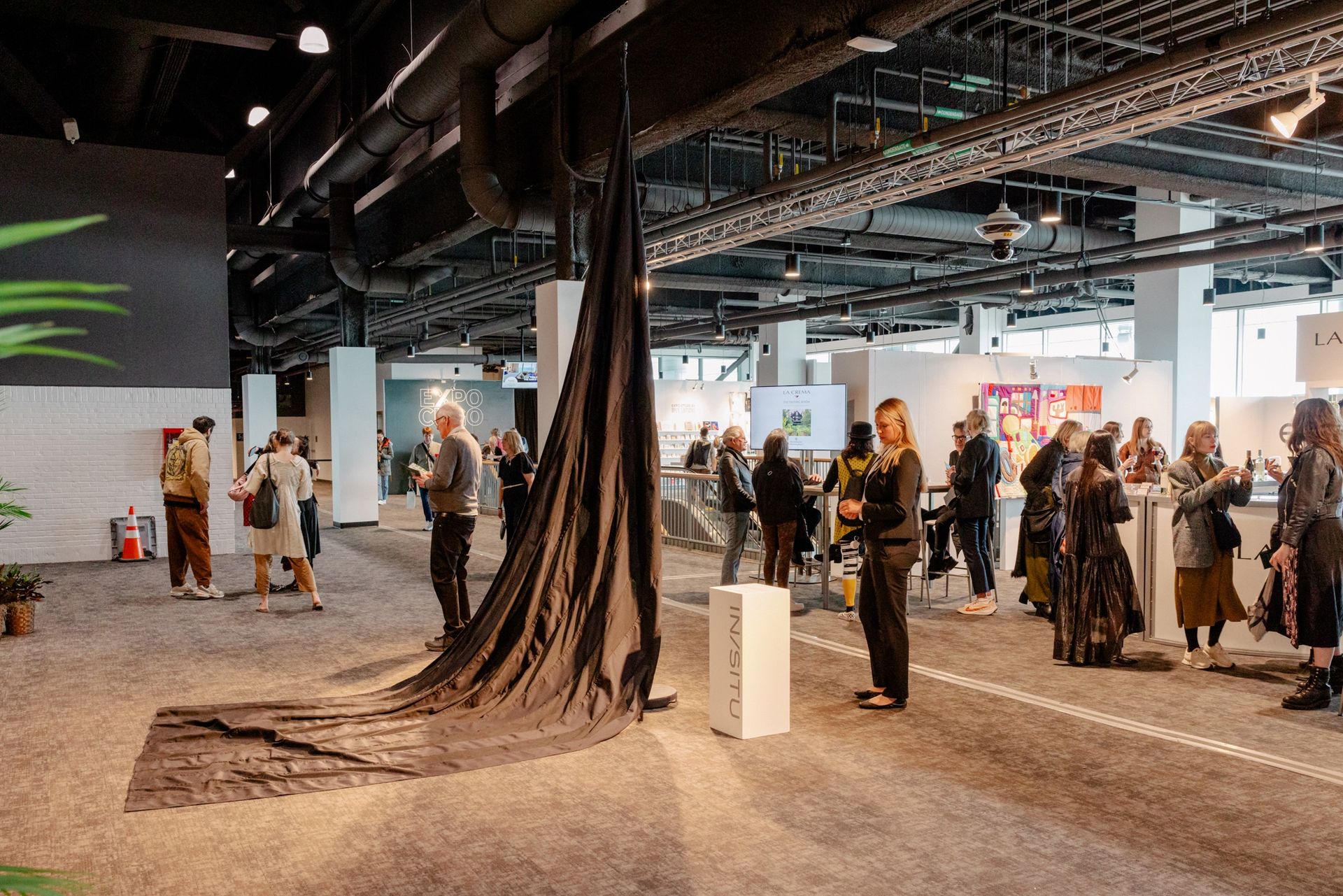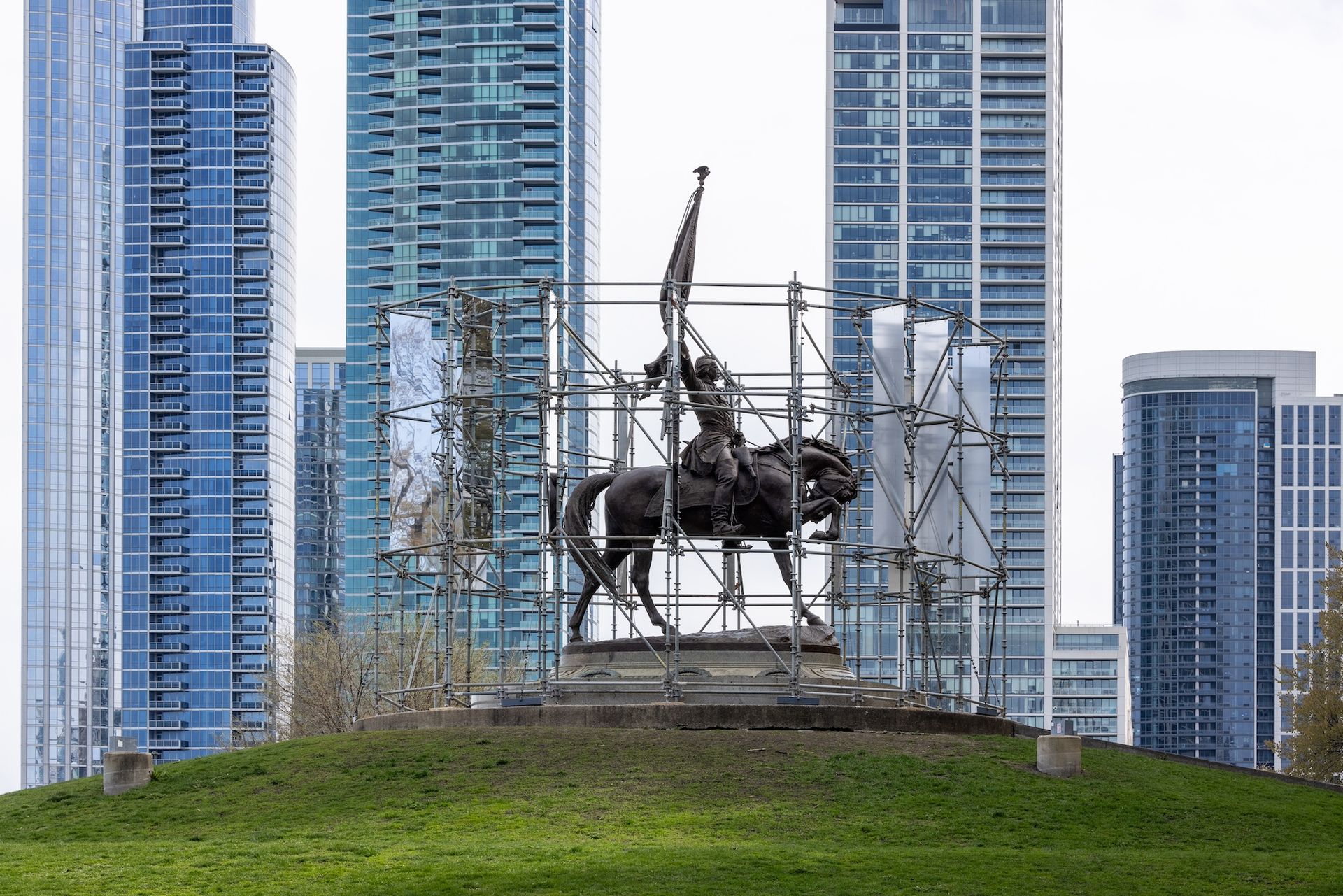Wrapping up its VIP preview on Thursday (11 April), the 11th annual Expo Chicago notched a first day comparable to its last under independent ownership—a promising sign of business as usual for the fair, which was acquired by London-based art conglomerate Frieze last July.
This year’s edition features 170 galleries, representing 75 cities in 29 countries—similar to last year’s, and roughly the maximum stall capacity possible in Navy Pier’s Festival Hall, Expo’s home since its move from downtown’s Merchandise Mart.
According to a next-day report provided by a spokesperson for Expo, hometown exhibitor McCormick Gallery and New York-, Singapore- and London-based Sundaram Tagore netted the VIP preview’s biggest sales, selling the late Mary Lee Abbott’s 1952 painting Imrie for $525,000 and a work by painter Hiroshi Senju for $385,000, respectively. Other major sales included a Wolf Kahn canvas from Miles McEnery Gallery ($150,000), Chiharu Shiota’s Endless Line from Gana Art ($121,000) and a large textile work by Marie Watt from Catharine Clark Gallery ($135,000).
In a recent interview with The Art Newspaper, Frieze chief executive Simon Fox expressed a commitment to retaining the “identities, histories and cultures” of Expo Chicago and New York’s Armory Show, both acquired by the conglomerate last year. For Expo president and director Tony Karman, that means keeping the focus on Midwestern galleries and artists.
2Visitors at the 2024 edition of Expo Chicago Courtesy Expo Chicago
When we launched Expo Chicago in 2012, we wanted to renew our place on the international art fair calendar, as Chicago always had, and also do what Chicago does best—and that’s collaborate with our institutions, our cultural community and amplify for the world what we’re doing,” he says.
Galleries from Chicago and the Midwest indeed claimed some of the fair’s most coveted real estate. Chicago stalwarts Rhona Hoffman and Corbett vs. Dempsey maintained their central locations on the Expo floor, right next to Brazilian artist Lucia Koch’s billboard-sized photography centrepiece, 3X3 Pots (2024), presented by Galeria Nara Roesler. Chicago- and Paris-based Mariane Ibrahim Gallery, returning to the exhibition after a yearlong caesura to open its Mexico City storefront, occupied a prime perch near the fair’s east entrance.
Pierre Lenhardt, Ibrahim’s partner in business and life, says the buyers he has seen so far reflect Expo Chicago’s usual demographics: Chicagooan, Midwestern and American collectors, in that order, with international buyers as a distinct minority. He noticed a more focused buyers’ market compared to the “frenzy” immediately following the Covid-19 shutdown and a relative slump in 2023.
“It’s more serious and focused on collecting… [This year’s buyers] are the ones who didn’t disappear,” Lenhardt says. “It speaks to resilience—going beyond the flavour of the moment.”
Repeat exhibitor Tandem Press, based in Madison, Wisconsin, also reported keen first-day interest in their offerings, which ranged from new works by Judy Pfaff and Suzanne Caporael to prints by Indigenous artist Jeffrey Gibson, who is representing the United States at this year’s Venice Biennale.

Reginald Madison, Blue Smoke, 1967 Courtesy September
“It feels like the first full year back since Covid,” says Tandem Press director Paula Panczenko.“Since first thing [Thursday] morning, there have been crowds of people coming through. There’s been no quiet times.”
Several non-local galleries centred Chicago artists in their stands, like London gallerist Cynthia Corbett (showing painter Ashley January) and Kinderhook, New York-based September (with a career overview of Reginald Madison, a veteran of Chicago’s Black Arts Movement). Other stands benefitted from recent local spotlights of their artists. ACA Galleries from New York saw multiple first-day sales of paintings by Faith Ringgold, the subject of a just-closed retrospective at the Museum of Contemporary Art. Copenhagen-based Gether Contemporary has a solo stand of aerated concrete works by Danish sculptor Sif Itona Westerberg, whose exhibition at Chicago’s Driehaus Museum culminates this weekend.
In one of Frieze’s most palpable changes to the fair thus far, stands in the Exposure sector—for galleries under 10 years old—formed a thick band off the centre of the Festival Hall rather than being sprinkled around its periphery. One of them, Bahamian exhibitor Tern, sold out its presentation of works by Kachelle Knowles, whose striking mixed-media portraits of Black men, rendered on brown paper, were prominently displayed at the corner of two well-trafficked thoroughfares.

Paul Stephen Benjamin, Black Flag, 2024, part of Expo Chicago’s In Situ programme and presented by New York gallery Efraín López Courtesy Expo Chicago
Within Expo Chicago’s churning kaleidoscope, many works offer explorations of monuments and monumentality. Site-specific installations in the fair’s In Situ programme, participatory works and individual stands all toyed with, or challenged, the position of art in codifying unassailable historical narratives. Paul Stephen Benjamin’s Black Flag (2024)—a massive, black-on-black reproduction of an American flag slouching on a too-short pole and sacrilegiously pooling on the ground—present by New York gallery Efraín López, greets visitors at the hall’s west entrance. As the preview went on, unwitting visitors tromped all over it, their pale footprints set in relief.
Further inside, Colombian artist Iván Argote’s Bust (2021) references an earlier intervention by the artist in Bogotá, in which he covered a statue of Francisco de Orellana, a conquistador and “discoverer” of the Amazon, with mirrors. Cuban artist Ariel Cabrera—represented by Havana- and Madrid-based gallery El Apartamento, in its sophomore Expo showing—also mined his country’s colonial history in a series of oil paintings depicting marble statues and 19th-century military figures alongside modern figures.

Brendan Fernandes, New Monuments | Chicago, 2024. General John Alexander Logan Monument, Grant Park, Chicago. Presented by Black Cube Nomadic Art Museum in association with the Chicago Park District, as part of Expo Chicago’s In Situ Outside program. Architectural intervention by AIM Architecture. Courtesy the artist and Black Cube Nomadic Art Museum. Photo: Matthew Reeves Photography.
A few miles away from Navy Pier, down Michigan Avenue, the Colorado-based non-profit Black Cube Nomadic Art Museum is presenting Chicago-based artist Brendan Fernandes’s New Monuments | Chicago (2024). For the project, Fernandes has sheathed a statue of general John Alexander Logan—who, prior to his service in the US Civil War, spearheaded state-wide legislation barring African Americans from settling in Illinois—in scaffolding and mirrors. At related collection boxes at Expo, Fernandes invites attendees to jot responses to the prompt, “How can we become the monument?”
Since its start as Art Chicago in 1980, Expo Chicago has become a local monument of its own. To the relief of long-time attendees, however, Frieze’s interventions so far appear minimal, even—tentatively—positive.
“Much of what I do, and did, hasn’t changed at all,” Karman says of planning this year’s fair. “What has changed positively is the opportunity to be a part of a much broader team that is deeply committed to the service of the galleries and the artists that they represent, and that can further expand our reach.”
Expo Chicago, until 14 April, Navy Pier, Chicago





















